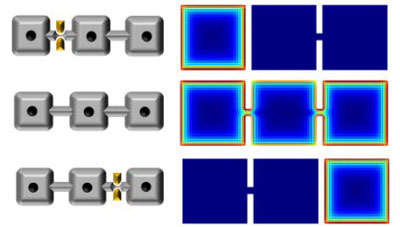| Oct 04, 2012 |
Designing a nano quantum device for manipulating majorana fermions
|
|
(Nanowerk News) Research associates Dr. Qi-Feng Liang and Dr. Zhi Wang, and PI Dr. Xiao Hu at the International Center for Materials Nanoarchitectonics (WPI-MANA; Director-General: Dr. Masakazu Aono), National Institute for Materials Science (President: Dr. Sukekatsu Ushioda) investigated theoretically the charge-neutral Majorana fermions, and proposed a method for their manipulation. Using a nano quantum device designed based on the topological properties of special superconducting states, Majorana fermions can be transported and exchanged by merely switching local gate voltage ("Manipulation of Majorana fermions by point-like gate voltage in the Vortex state of a topological superconductor"; open access).
|
 |
| Transport of Majorana particles by switching gate voltages at the constriction junctions. However, Majorana particles captured in the core of superconducting vortex are not shown here explicitly.
|
|
Majorana fermion was proposed by the Italian theoretical physicist Ettore Majorana in 1937, but their existence has not yet been confirmed as elementary particle. Recently it has been revealed that quasiparticle excitations of special superconducting states behave similarly to Majorana fermions. While Majorana fermions may be stable due to charge neutrality, they are difficult to manipulate using an external field for the same reason.
|
|
The MANA research group confirmed that, unlike electrons and photons, braiding of Majorana particles in the designed quantum device obeys non-Abelian statistics, which can be used for quantum computation. This research result contributes to the key technology of topological quantum computation.
|

